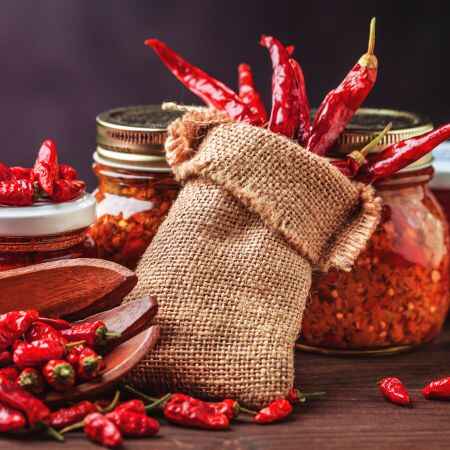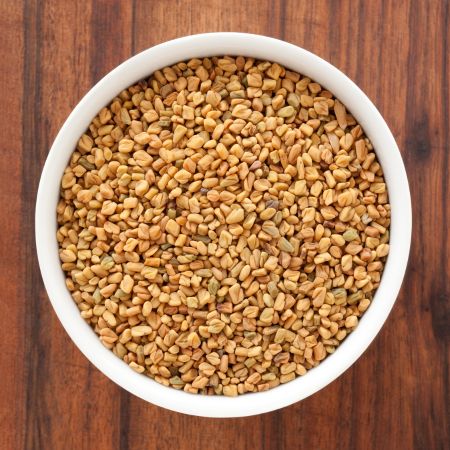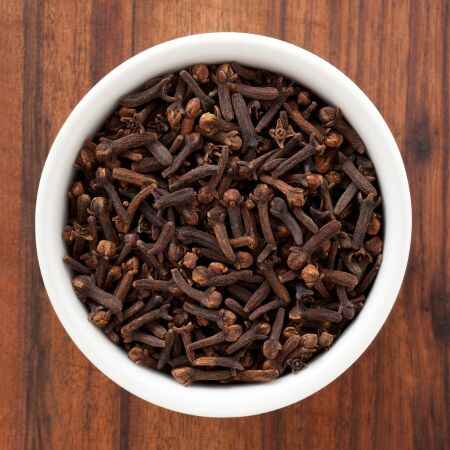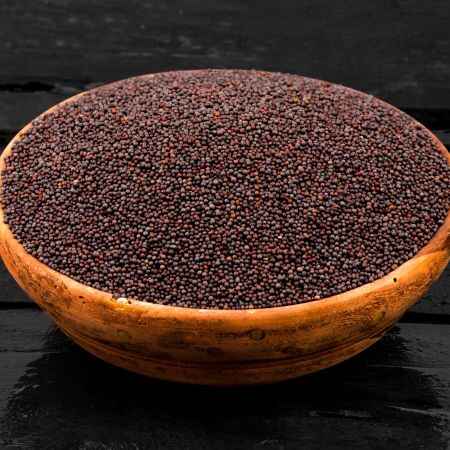


Color :- Red chilli will have a vibrant, consistent red color. Uniformity in color is crucial as it indicates quality and freshness..
Aroma :- Red chillies will possess a strong, characteristic aroma that reflects their pungency and essential oil content.
Purity :- The chillies will be free from any foreign matter such as dust, dirt, stones, or other plant materials. Impurities should be minimal. Adulterants: Red chillies should be pure and free from any adulterants or contaminants.
Moisture Content :- The moisture content will be low, generally between 10-12%, to prevent mold growth and ensure longevity during storage and transportation.
Packaging :- Red chillies will be packed in clean, dry, and food-grade materials to prevent contamination. Common packaging options include jute bags, polypropylene bags, or laminated pouches with proper labeling. Packaging should protect the chillies from moisture, pests, and physical damage during transit.

Appearance :- Cumin seeds will have a uniform yellow-brown to light brown color.
Shape :- The seeds will be elongated, oval, and ridged, with a consistent size and shape.
Aroma :- Cumin seeds will have emit a strong, earthy, and warm aroma, indicative of their essential oil content
Purity :- Seeds will be free from any foreign matter such as dust, stones, dirt, or other plant materials
The moisture content :- will be low, generally between 8-10%, to prevent mold growth and ensure longevity during storage and transportation.
Size and Shpae :- Cumin seeds will be uniform in size, typically between 3-6 mm in length. Consistency in size is crucial for export quality.
Packaging :- Cumin seeds will be packed in clean, dry, and food-grade materials to prevent contamination. Common packaging polypropylene bags, or laminated pouches with proper labeling.



Purity :- The fenugreek seeds will be free from contaminants, foreign materials, and adulterants. High purity levels (usually above 99%) are desirable.
Moisture Content :- The moisture content will be low, generally below 10%, to prevent mold and microbial growth during transportation and storage.
Color and Size :- Uniformity in color and size of the seeds is essential. They will have a consistent golden-brown color and be free from discolored or immature seeds.
Aroma and Flavor :- The seeds will have a strong, characteristic aroma and a slightly bitter taste, which are indicators of freshness and quality.
Pesticide Residue :- Compliance with international standards for pesticide residues is mandatory. The seeds should be tested and certified to be within safe limits.
Packaging :- The packaging should ensure the seeds are protected from moisture, pests, and contamination. Vacuum-sealed or nitrogen-flushed packaging is often used to maintain freshness.
Labeling :- Accurate and clear labeling with information such as batch number, date of harvest, country of origin, and any certifications (e.g., organic, non-GMO) is important.

Color :- Green cardamom pods will have a vibrant, uniform green color. The color should be fresh and indicative of high quality.
Shape and Size :- The pods will be plump, well-formed, and uniform in size, typically ranging from 6-8 mm in diameter.
Aroma :- Cardamom will have a strong, sweet, and characteristic aroma, which is a sign of its essential oil content, primarily cineole and terpinyl acetate
Flavor :- The flavor should be sweet, spicy, and aromatic, providing a pleasant and distinctive taste.
Purity :- Cardamom will be free from any foreign matter such as dust, dirt, stones, or other plant materials. Impurities should be minimal.
Moisture Content :- The moisture content will be low, generally between 10-12%, to prevent mold growth and ensure longevity during storage and transportation.
Chemical Residue :- Cardamom must comply with international standards for pesticide residues and other chemicals. It should be free from harmful substances that could pose health risks.
Packaging :- Cardamom will be packed in clean, dry, and food-grade materials to prevent contamination., polypropylene bags, or laminated pouches with proper labeling. Packaging should protect the cardamom from moisture, pests, and physical damage during transit.



Color : Black pepper will have a consistent dark brown to black color, indicative of its ripeness and quality.
Size and Shape :- The peppercorns will be uniform in size, typically 4-6 mm in diameter, and spherical in shape.
Aroma :- Black pepper will have a strong, pungent, and characteristic aroma, which is a sign of its essential oil content, primarily piperine.
Purity :- Black pepper will be free from any foreign matter such as dust, dirt, stones, or other plant materials. Impurities should be minimal.
The moisture content :- will be low, generally between 10-12%, to prevent mold growth and ensure longevity during storage and transportation
The essential oil content :- particularly piperine, will be high. This is a key indicator of the pepper's quality and potency.
Chemical Residue :- Black pepper must comply with international standards for pesticide residues and other chemicals. It should be free from harmful substances that could pose health risks.
Packaging :- black pepper will be packed in clean, dry, and food-grade materials to prevent contamination. polypropylene bags, or laminated pouches with proper labeling.

Appearance :- Cloves wil be uniform in color, typically dark brown or reddish-brown, with a glossy surface.
Size and Shape :- The length of the cloves will be consistent
Aroma :- Cloves will have a strong, pungent, and characteristic aroma
Moisture Content :- The moisture content generally between 8-12%
Packaging :- Polypropylene bags, or laminated pouches



Purity :- Mustard seeds will be free from contaminants, foreign materials, and adulterants. High purity levels (usually above 99%) are essential.
Moisture Content :- The moisture content will be low, typically below 8-10%, to prevent mold and microbial growth during transportation and storage.
Color and Size :- Uniformity in color and size is crucial. Depending on the type (yellow, black, or brown mustard seeds), the seeds should have a consistent color and be free from discolored or immature seeds.
Aroma and Flavor :- Mustard seeds will have a characteristic pungent aroma and a sharp, biting taste, which are indicators of freshness and quality.
Oil Content :- High oil content is often preferred, especially for processing purposes. Ensure the oil content meets the buyer's specifications.
Pesticide Residue :- Mustard seeds will comply with international standards for pesticide residues. Testing and certification are necessary to ensure they are within safe limits.
Packaging :- Packaging will protect the seeds from moisture, pests, and contamination. Options include vacuum-sealed, nitrogen-flushed, or multi-layered bags.
Labeling :- Accurate and clear labeling with information such as
batch number, date of harvest, country of origin, and any certifications (e.g., organic,
non-GMO) is essential

Purity :- Ginger seeds will be free from contaminants, foreign materials, and adulterants. High purity levels are essential for market acceptance.
Moisture Content :- The moisture content will be low, typically below 8-10%, to prevent mold and microbial growth during transportation and storage.
Moisture Content :- The moisture content will be low, typically below 8-10%, to prevent mold and microbial growth during transportation and storage.
Size and Shape :- Uniformity in size and shape is important. The seeds will be consistent in appearance and free from broken or damaged pieces.
Color and Texture :- The seeds will have a natural, consistent color and a firm texture. Discoloration or shriveling can indicate poor quality or aging.
Aroma and Flavor :- Fresh ginger seeds will have a strong, characteristic aroma and a slightly spicy flavor, indicating freshness and quality.
Pesticide Residue :- Compliance with international standards for pesticide residues is mandatory. The seeds will be tested and certified to be within safe limits.
Packaging :- The packaging should protect the seeds from moisture, pests, and contamination. Vacuum-sealed or nitrogen-flushed packaging is often used to maintain freshness.
Labeling :- Accurate and clear labeling with information such as batch number, date of harvest, country of origin, and any certifications (e.g., organic, non-GMO) is important



Color :- Cinnamon will have a consistent brown or golden-brown color, indicative of its freshness and quality.
Shape and Size :- The sticks will be tightly rolled, with uniform thickness and length. Whole sticks are preferred over broken pieces.
Aroma :- Cinnamon will have a strong, sweet, and warm aroma, which is a sign of its essential oil content, mainly cinnamaldehyde.
Purity :- Cinnamon will have a consistent brown or golden-brown color, indicative of its freshness and quality.
Moisture Content :- The moisture content should be low, generally between 10-12%, to prevent mold growth and ensure longevity during storage and transportation.
Oil Content :- The essential oil content, particularly cinnamaldehyde, should be high. This is a key indicator of the cinnamon's quality and potency.
Defects :- The sticks will be free from visible defects such as mold, splits, or excessive bark. The percentage of defective cinnamon sticks should be minimal.
Chemical Residue: :- It will be free from harmful substances that could pose health risks.
Packaging :- Cinnamon will be packed in clean, dry, and food-grade materials to prevent contamination. polypropylene bags, or laminated pouches with proper labeling. Packaging should protect the cinnamon from moisture, pests, and physical damage during transit.

Color :- Turmeric will have a vibrant, uniform yellow-orange color, indicative of high curcumin content and freshness.
Form :- Turmeric can be in the form of whole fingers, bulbs, or powder. Each form should be consistent in appearance and free from blemishes.
Aroma :- Turmeric will have a strong, earthy, and slightly peppery aroma, which is a sign of its essential oil content.
Purity :- Turmeric will be free from any foreign matter such as dust, dirt, stones, or other plant materials. Impurities should be minimal
The moisture content :- will be low, generally between 5-10%, to prevent mold growth and ensure longevity during storage and transportation.
Chemical Residue :- Turmeric must comply with international standards for pesticide residues and other chemicals. It should be free from harmful substances that could pose health risks.
Packaging :- Turmeric will be packed in clean, dry, and food-grade materials to prevent contamination. polypropylene bags, or laminated pouches with proper labeling.

